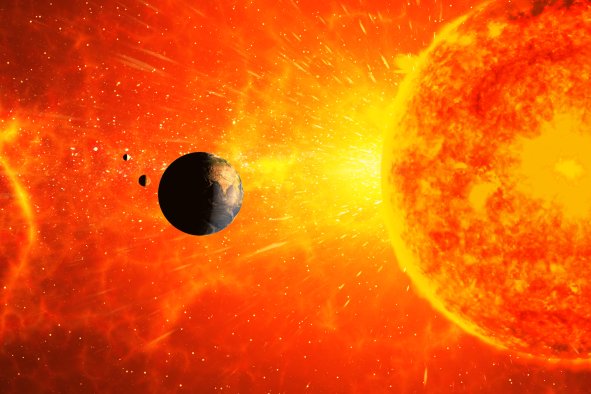New pictures of a distant nebula have revealed what appears to be a gargantuan hand made of dust and gas, stretching through space.
The spooky sight was spied around 1,300 light years away from our solar system, in the constellation of Puppis, and shows the hand appearing to reach out towards the spiral galaxy ESO 257-19 (PGC 21338).
The dusty structure, named CG 4, is actually something called a cometary globule, according to a statement from researchers at the NSF NOIRLab (U.S. National Science Foundation National Optical-Infrared Astronomy Research Laboratory), and is nowhere near the galaxy in the picture, which has aligned with the hand by chance.
Cometary globules are one of a larger group of space objects called Bok globules, small, dark nebulae made of clouds of dense gas and dust. These are areas where stars often form in space, being mostly made up of hydrogen, carbon oxides, and helium, and tend to have a mass of between 2 and 50 times that of our sun.
Bok globules are usually surrounded by hot, ionized gas and dust, which can sometimes start to strip off, forming trails that look something like the tail of a comet. These types of Bok globules in particular are known as cometary globules, which were first discovered in 1976.
CG 4 is around 1.5 light-years in diameter, with an 8 light-year-long tail, making it a relatively small Bok globule. Exactly how cometary globules gain their strange shape is still unclear to scientists, with some theories suggesting that they may have begun as sphere-shaped nebulas that were blown aside by a supernova nearby. Other hypotheses suggest that they are formed as a result of stellar winds from nearby enormous stars or other objects.
CG 4, alongside 31 other cometary globules, is located in something called the Gum Nebula, in the center of which are the Vela Supernova Remnant and Vela Pulsar. As all the cometary globules' tails are pointing away from these energetic objects, the supernova or stellar winds from the pulsar may have shaped the globules into their unique form.
This image of CG 4 was captured by the Department of Energy-fabricated Dark Energy Camera (DECam) mounted on the U.S. National Science Foundation Víctor M. Blanco 4-meter Telescope at Cerro Tololo Inter-American Observatory (CTIO), which was powerful enough to pick up a faint glow of red hydrogen gas within the head and rim of the globule. This light is only produced when hydrogen gas is heated up enough, indicating that there are large, hot stars within the clouds.
The astronomers think that CG 4 contains enough gas to birth several stars the size of our sun, though the radiation released by these young stars is slowly eroding the head of the globule.
Do you have a tip on a science story that Newsweek should be covering? Do you have a question about cometary globules? Let us know via science@newsweek.com.
Disclaimer: The copyright of this article belongs to the original author. Reposting this article is solely for the purpose of information dissemination and does not constitute any investment advice. If there is any infringement, please contact us immediately. We will make corrections or deletions as necessary. Thank you.



